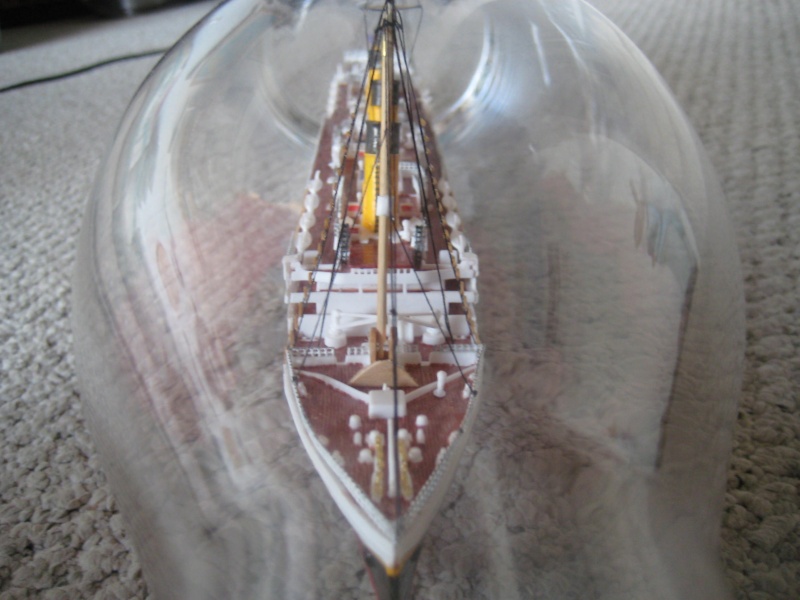
Bottling with Caution:
How to avoid the accidental broken bottle Shipwreck!
Every ship in bottle guy may have their own methods, but there is always more than one way to do them!
I often learn from my ship wrecks in this art, I would like to share some tips on how to avoid the bottled ship wreck.
The Ship in bottle project must be free and sterile of fungi’s and potential mold… and there should be no elements of trace water moister in the finished project.
Failure in this area could result in a ship in bottle that could rot away and a fogged up glass with track marks made by microscopic single celled bacterium…the art piece would get ugly with time.
Select time tested materials… paint that resist fading non corrosive material…durable cloth for sails…Imagine that your vessel could live beyond your children’s, children’s years!
Selecting a proper glass bottle for the project is key to building a nice quality piece of folk art, the bottle should not be too distorted, cracked or too thick or thin…..If you did it anyways, you got away with it and was lucky…but this is about experience and skill and to HELL with LUCK!
I have had very unusual accidents with some bottles actually breaking due to drastic temperature changes.
I often heat my bottles in the kitchen in a pan of hot water and then insert small amounts of wax and modeling clay, this forms nice even waterline, part of the vessel foundation could be added at this point so the rest of the ship could be added later after it finally cools…While the water is cooling, waves could be stirred up with a straw or long tools.!- Allow the bottle to slowly cool.
As I said the bottle must be free of Cracks or any damage or excessive bubbles… heating up any bottle is always a risk….make sure your chosen risk is worth it.
As I said the proper bottle must be of high quality for the use of the heating process!....sometimes there are bottles that heat up unevenly and this is too much for the glass… at which point the bottle will pop!... be ready to bottle the ship in a back up vessel or omit using heat to make the seas…some bottles are also too big to risk the heat method to heat or cool.
Alternate to rubber cement, paint , resin or silicon…even putting in the clay the Olde fashioned way with a very long stick!
Still there is a risk that a bottled ship cold still mysteriously break…One time I built a biplane inside a light bulb and hours later it suddenly cracked!....I later discovered that extreme weather temperature change could cause the glass around the object to contract…The biplane was indeed smaller than the bulb could handle!
Thick glassed bottles are also not immune to the cold…I built a Galleon for my father in California and finally corked it…It was 88 degrees during the day but it dropped to the 50s…..during the night my family opened all the windows in the room the vessel was being kept….and I then again hear the horrible pop!
The bottle had contracted around the cork too tightly…there was nothing I could do, the damage was done!
All I can advise is that any bottled folk art must take into account this damaging element.
Other special effect risks may involve the use of fire!....
Be sure a bottled art piece if properly free of fumes, any open flame nearby could ignite it!....I have this one burned vessel schooner which was fully rigged… now rigged no more, I was using a red hot wire from a candle to burn away the final lines that pulled up the rigging… a contained explosion occurred blowing the wire out of my hand like a cannon!
Cutting with red hot wires is not unusual but how about using the sun?
On a nice sunny day a magnifying glass could be used to burn away or create great special effect on a finished model to remove lines in otherwise impossible areas to cut or reach.- be prepared to wet the areas you do not wish to burn or the model will keep on burning like a cigarette!
Of course every experienced salt will pull the lines to raise the mast but occasionally there is an entanglement of mast and rigging….SLOW DOWN!....study the vessel and investigate the mess….pulling the wrong lines could actually make things far worst!
Do not store bottled ships in the reach of the sun’s rays!....your vessel may refract the suns energy and start a fire, possibly burning something, a nasty mark on the table or the whole house!....Consider all glass art potential sun magnifiers!
Finally your vessel is done…at which point it may be ready for display or sale…..Remember that you being the builder is also the key if there is such a time that a bottled art piece needs to be rebottled because an incident with the cat!
Hopefully, your art piece will remain in perfect preservation for generations to come and live an uneventful life amazing people where ever it is displayed.

